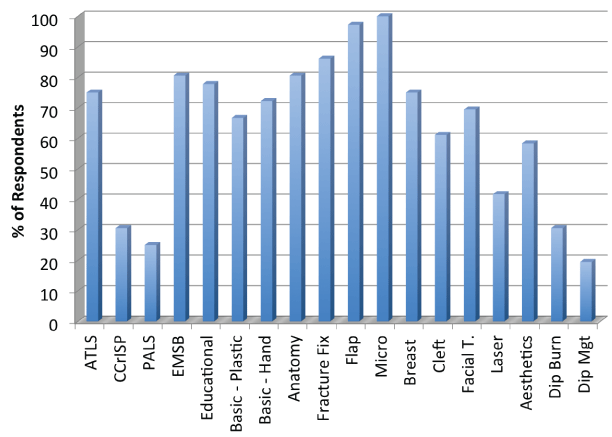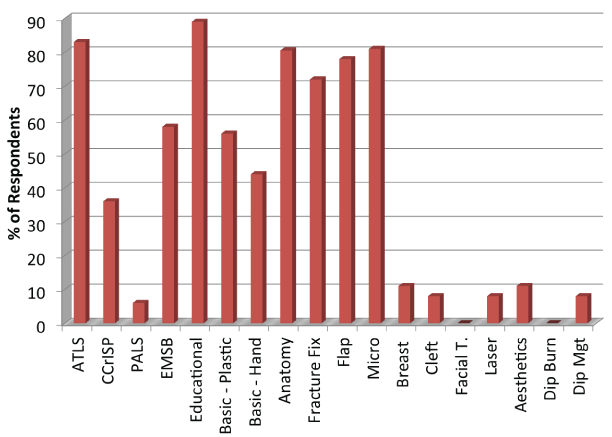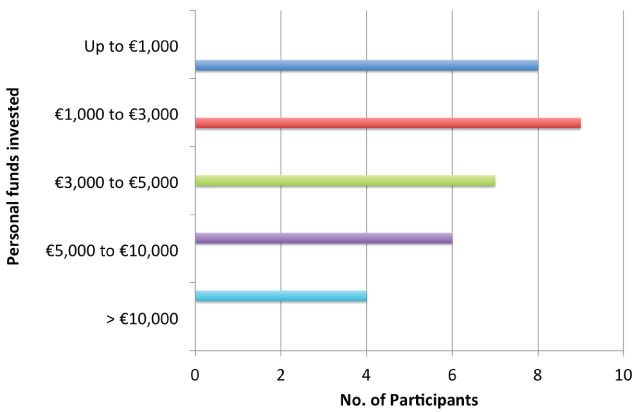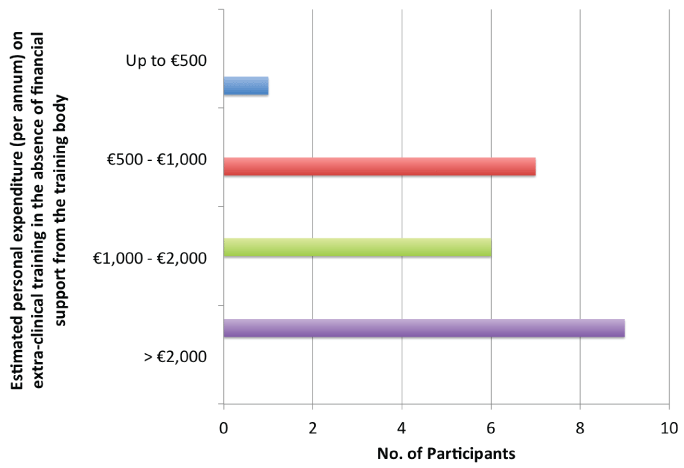The manner in which surgical training is delivered is changing. Internationally, work practice reform has challenged surgical educators to provide the same level of experience in an environment of reduced clinical contact hours. Extra-clinical training courses afford the opportunity to improve both technical proficiency and knowledge base, yet enrolment has significant implications for participants. The aim of this study was to ascertain the correlation between the perceived importance of specific extra-clinical courses to plastic surgery training with the rate of course uptake. The motivational factors responsible for course enrolment were also identified; in addition to the inherent financial implications and the burden on personal leave entitlements. Consultant plastic surgeons and trainees on the national plastic surgery training program were invited to participate in this cross-sectional opinion study. A bespoke online questionnaire was designed using QuestionPro™ online survey software. The response rate was 64% (n = 36). The majority considered the surveyed courses to be important to their continuing professional development and enrolled in order to improve knowledge and technical proficiency. A significant, strongly positive correlation was demonstrated between the ranked importance of such training and rate of course uptake (rs (8) = 0.766, p < 0.001), indicating that respondents prioritized participation in order of perceived importance. Non-educational leave was used by all (n = 36) to facilitate course enrolment, whilst participation resulted in the use of personal funds by 94% (n = 34) of the study group. In an era of economic uncertainty, the financial implications, in conjunction with the impact on quality of life, necessitate the development of accessible and cost-effective extra-clinical training solutions that complement the available operating exposure. Further study is warranted.
Surgical training, Plastic surgery course, Plastic surgery training, Simulation, Continuing professional development
The manner in which surgical training is delivered is changing. While the operating theatre affords the ideal opportunity for the development of technical proficiency, numerous constraints, legislative and otherwise, have restricted such practical experience and are likely to continue to do so in the future [1,2]. In Europe, the reduction in duty hours has substantially curtailed the operative exposure of surgical trainees since the introduction of the European Working Time Directive [3,4]. In plastic surgery specifically, the change in working patterns has dramatically reduced the exposure to emergency operating in the early years of training [5]. The introduction of the Accreditation Council for Graduate Medical Education 80-hour work week in the US, has also been associated with a considerable reduction in operative opportunities for surgical residents [6]. The reduction in duty hours coupled with an increasing requirement to meet specific patient safety standards has resulted in a move towards a competency-based training system. This, in turn, has stimulated significant expansion in the development of surgical skills laboratories worldwide, to allow for development of skills whilst complying with safe working times [7].
Surgical simulators are considered an appropriate modality for surgical training. They facilitate objective assessment of competency in specific surgical procedures [8]. It has also been proposed that simulators can improve surgical care, reduce errors, increase patient safety and maximize hospital resources [9]. The acquisition of knowledge and the development of technical proficiency in a non-clinical environment have many reported advantages. Patients are not exposed to early learning curves [10]. The learning environment can be more supportive, away from the pressures of service provision and time-limited operative lists [11-13]. A myriad of plastic surgery-specific simulators exist [9,14]. Such extra-clinical programs have been associated with an improvement in core knowledge in addition to increasing the level of confidence of participants [14]. Technically demanding skills, such as those used in microsurgery, can be both maintained and enhanced through short, intensive periods of practical instruction. These benefits are applicable to surgeons at all levels of training [11].
Internationally work practice reform has, in essence, challenged surgical educators to provide the same level of experience in an environment of reduced clinical contact hours [9,15]. Those in pursuit of technical excellence are therefore encouraged to be proactive in their training needs in an era of diminishing operative opportunities. The availability of high-quality extra-clinical resources, however, does not guarantee their uptake by surgeons in training [16]. A cost-benefit analysis is performed taking into consideration a range of variables, including perceived importance, relevance to training and financial factors. With regard to the latter, the cost of course attendance can be considerable, and includes registration fees in addition to travel and accommodation expenses. Educational debt remains a significant burden for many surgeons with debts in excess of $200,000 reported [17]. In addition, surgeons in training tend to accrue higher non-educational debts and have less savings than both controls matched primary-care trainees and the general public [18]. Indeed, when questioned on life stressors, personal finances ranked of the highest concern to surgeons in post-residency training positions and ranked second most concerning to practicing surgeons and residents [19]. In the current era of global economic turmoil, the availability of designated funds for surgical education and training has diminished [20], increasing the cost to the participant which, in turn, has inherent negative implications on likelihood of course enrolment.
The primary outcome of the study was to determine the perceived importance of specific extra-clinical courses among consultants and trainees in a national plastic surgery training program and to ascertain the correlation between the demands for such courses with the rate of course uptake. Secondary outcomes included identification of the catalysts responsible for course enrolment and analysis of the burden of course attendance on annual leave entitlements. The financial implications of extra-clinical training were also evaluated; specifically ascertaining the extent of personal investment required meeting the shortfall generated by course participation.
Consultant plastic surgeons and trainees on the national plastic surgery training program were identified via the database of the Royal College of Surgeons in Ireland. They were subsequently invited, via email, to participate in this cross-sectional opinion survey. A bespoke, study-specific questionnaire was designed using QuestionPro™ online survey software. The survey was constructed with input from literature reviews in addition to working group discussions and telephone conferences between the authors. During the development phase, the precise information to be obtained was agreed upon to ensure the research objectives were satisfied. In order to standardize the questionnaire a combination of closed (n = 6, 20%), open-ended (n = 2, 7%) and open response-option (n = 22, 73%) questions were utilized. A pre-test was subsequently conducted to ensure the instructions, language, wording and order of questions was appropriate. The final version, ratified by the senior author, consisted of 30 multiple-choice questions.
The first section was comprised of closed questions, which allowed for efficient collection of baseline demographic data within standardized ranges. An open response-option question was used to ascertain the perceived importance of a variety of courses deemed relevant by the authors to plastic surgery training. These included: Advanced Trauma Life Support (ATLS), Care of the Critically Ill Surgical Patient (CCrISP), Pediatric Advanced Life Support (PALS), Emergency Management of Severe Burns (EMSB), educational seminars, basic skills in plastic surgery and hand surgery, anatomical dissection, fracture fixation, flap dissection, microsurgery, breast reconstruction, cleft and craniofacial surgery, facial trauma, laser, aesthetic surgery and diplomas in burn management and healthcare management respectively. Participants were asked to rank the importance of the specified courses using a five-point Likert scale (Likert 1932) where scores of one or two indicated the course was not considered important and scores of four or five registered the course as important to plastic surgery training. The percentage of respondents who considered each of the individual courses surveyed as important to plastic surgery training, indicated by Likert scores of both four and five, was subsequently calculated.
A closed question was utilized to determine the breakdown of courses attended by the study cohort. Such is the diversity of the specialty however, that a free text option was incorporated to ensure comprehensive assessment of all courses attended by participants.
With regard to the secondary outcomes, an open response-option question was constructed to evaluate the burden of course attendance on personal leave entitlements. An additional open response-option question with a free text subsection was used to identify the motivating factors behind course enrolment. The financial implications of participation were also evaluated. Subjects were asked to estimate the total financial burden of all extra-clinical training that they had undertaken in their careers to date. The possibility of future withdrawal of financial support for these activities by the national training body was also explored. Trainees were asked to estimate what their annual personal expenditure would be in the absence of any financial support.
All questionnaires were completed in an anonymous fashion and the results were recorded on a database by an author. The mean ranking for each course listed was calculated. The means were also ranked from highest to lowest to determine the overall rankings. For the purposes of comparative analysis, the data was tested for normality using Shapiro-Wilk tests and non-parametric analysis was used (SPSS® Statistics Version 20). Spearman's rank-order correlation was used to determine the relationship between the perceived importance of specific training courses and the likelihood of course attendance by the study group. P values were considered significant at values less than or equal to 0.05. Qualitative responses were coded based on a rubric designed by the authors (A.M.C., P.F.R). After viewing the responses to the two free text subsections, responses regarding courses attended were designated into one of seven additional categories. For the second free text subsection concerning the motivating factors responsible for course enrolment, answers were assigned to one of five categories, namely improvement of technical proficiency, expansion of knowledge, attainment of a senior specialist training position, fulfillment of continuing medical education requirements and networking/socializing. Once the categories were identified, the authors independently coded each response and collaborated to classify or exclude any incongruous answers.
The study group (n = 56) consisted of consultant plastic surgeons (n = 19) and trainees on the national plastic surgery training program (n = 37). The overall response rate to the online questionnaire was 64% (n = 36). With regard to professional status, 33% (n = 12) were junior plastic surgery trainees (yet to commence accredited training), 31% (n = 11) were senior plastic surgery trainees (in accredited training), 3% (n = 1) were at fellowship level and 33% (n = 12) were consultants. Fifty-eight percent (n = 21) of respondents were male and 42% (n = 15) were female.
Regarding the primary outcome, microsurgical training, flap dissection and fracture fixation courses were ranked as the three most important extra-clinical courses by participants (Figure 1 and Table 1). An overwhelming majority, of 100% and 97% respectively, acknowledged the inherent importance of microsurgery and flap dissection, with over 80% of respondents deeming fracture fixation, EMSB and anatomical dissection courses to be important to plastic surgery training. Between 70% and 80% recognized the importance of educational seminars, breast reconstruction courses, ATLS and basic skills courses in hand surgery, while 50% to 69% considered courses in the facial trauma, cleft and craniofacial surgery, aesthetic surgery and basic skills in plastic surgery to be important. Less than 50% of respondents regarded laser training courses, CCrISP, PALS and diplomas in burns and healthcare management important to their plastic surgery training.
 Figure 1: Bar chart demonstrating the percentage of respondents who ranked specific extra-clinical courses as important to plastic surgery training.
Figure 1: Bar chart demonstrating the percentage of respondents who ranked specific extra-clinical courses as important to plastic surgery training.
ATLS: Advanced Trauma Life Support; CCrISP: Care of the Critically Ill Surgical Patient; PALS: Paediatric Advanced Life Support; EMSB: Emergency Management of Severe Burns; Educational: BAPRAS & BSSH Advanced Educational Seminars; Basic Plastic: Basic Skills in Plastic Surgery; Anatomy: Anatomical Dissection Courses; Fracture Fix: Fracture Fixation; Flap: Flap Dissection; Micro: Microsurgery; Breast: Breast Reconstruction; Cleft: Cleft and Craniofacial Surgery; Facial T: Facial Trauma; Dip Burn: Diploma in Burn Management; Dip Mgt: Diploma in Medical Management. View Figure 1
Table 1: Table demonstrating the perceived importance, rate of uptake, in addition to the mean, overall and median rankings of a selection of extra-clinical training courses. The importance was ranked on a five point Likert scale, where scores of 4 or 5 indicated participants perceived the course to be important to plastic surgery training. View Table 1
With regard to course uptake, a total of 263 courses were completed by the study group, equivalent to a mean of seven courses per respondent. The breakdown of course attendance is presented in Figure 2. Over 80% of respondents attended international plastic and hand surgery educational seminars in addition to ATLS, anatomical dissection and microsurgery courses. Between 70% and 80% participated in fracture fixation and flap dissection courses and 40% to 60% completed EMSB and the basic skills courses. A minority (between 8% and 11%) attended courses in cleft and craniofacial surgery, lasers and breast reconstruction.
 Figure 2: Bar chart demonstrating the attendance rate at specific extra-clinical training courses.
Figure 2: Bar chart demonstrating the attendance rate at specific extra-clinical training courses.
ATLS: Advanced Trauma Life Support; CCrISP: Care of the Critically Ill Surgical Patient; PALS: Paediatric Advanced Life Support; EMSB: Emergency Management of Severe Burns; Educational: BAPRAS & BSSH Advanced Educational Seminars; Basic Plastic: Basic Skills in Plastic Surgery; Anatomy: Anatomical Dissection Courses; Fracture Fix: Fracture Fixation; Flap: Flap Dissection; Micro: Microsurgery; Breast: Breast Reconstruction; Cleft: Cleft and Craniofacial Surgery; Facial T: Facial Trauma; Dip Burn: Diploma in Burn Management; Dip Mgt: Diploma in Medical Management.
View Figure 2
Spearman's Rank Order correlation was subsequently performed to determine the relationship between the perceived importance of specific extra-clinical courses to plastic surgery training and the rate of course enrolment. There was a strong, positive correlation between perceived importance and rate of course uptake, which was statistically significant (rs (8) = 0.766, p < 0.001).
With regard to the secondary outcomes, the key motivating factors behind extra-clinical courses participation were identified as improvement of surgical skills (34%, n = 12) and expansion of knowledge (34%, n = 12). Additional rationale included attainment of an accredited specialist training position (18%, n = 7), fulfillment of Continuing Medical Education (CME) requirements (10%, n = 4) and networking/socializing (4%, n = 1).
From a financial perspective, 83% (n = 30) of participants received support from the national training body during the course of their professional training. Despite this financial assistance, 94% (n = 34) utilized personal funds to meet the shortfall generated by course enrolment. Subsequent analysis of individual responses revealed 23% (n = 8) have invested up to € 1,000 to date, 26% (n = 9) have invested between € 1,000 and € 3,000, 21% (n = 7) have invested between € 3,000 and € 5,000, 18% (n = 6) have invested between € 5,000 and € 10,000 and 12% (n = 4) have invested in excess of € 10,000 (Figure 3).
 Figure 3: Bar chart depicting estimations of personal funds invested by participants in extra-clinical training to date. View Figure 3
Figure 3: Bar chart depicting estimations of personal funds invested by participants in extra-clinical training to date. View Figure 3
Trainees (n = 24) were subsequently asked to estimate what their annual personal expenditure on extra-clinical training would be in the absence of financial support from the national training body. The majority (96%, n = 23) of respondents confirmed they would be prepared to forgo a portion of their income in lieu of continuing professional development (Figure 4). Of this cohort, four per cent (n = 1) confirmed they would invest up to € 500 per annum (p.a.), 31% (n = 7) stated they would invest between € 500 and € 1,000 p.a., 26% (n = 6) declared they would invest between € 1,000 and € 2,000 p.a., and 39% (n = 9) were willing to invest in excess of € 2,000 p.a.
 Figure 4: Bar chart illustrating estimated personal expenditure per annum on extra-clinical training in the absence of financial support from the national training body.
View Figure 4
Figure 4: Bar chart illustrating estimated personal expenditure per annum on extra-clinical training in the absence of financial support from the national training body.
View Figure 4
Attendance at extra-clinical courses necessitated the usage of non-educational leave by all participants (100%, n = 36). Eighty-one per cent (n = 29) have used up to two weeks of annual leave, 8% (n = 3) have used two to three weeks and 12% (n = 4) have used three to six weeks respectively.
Workplace reforms such as a mandated reduction in clinical contact hours for trainees and proportional increases in service provision by consultants have been welcomed for optimizing patient safety and improving the quality of surgical education. Concerns have been raised by a number of sub-specialties however regarding the inherent negative implications on training [21]. The specialty of plastic surgery is particularly susceptible to the restraints of this new training environment due to its broad scope of practice and diverse procedural skill set. It presents certain challenges to trainees who must strive to be practice-ready in a shorter time period than their historical counterparts. It is essential, therefore, that the training provided by surgical educators is deemed pertinent to continuing professional development by plastic surgeons. Seventy-two per cent of the adjunctive training modalities evaluated in this study were considered important by more than 50% of respondents. In addition, a significant, strongly positive correlation was demonstrated between the importance of such training and the rate of course enrolment, indicating that respondents prioritize participation in order of perceived importance.
Extra-clinical training is commended for affording the opportunity to improve technical proficiency and knowledge base, yet course enrolment has significant implications for participants. Although surgeons have long been recognized as willing to make extraordinary sacrifices to excel in their profession [22] the financial burden of adjunctive training is significant. Our findings confirmed that participants have invested a considerable proportion of their personal income in continuing professional development, with more than 50% investing in excess of € 3,000 and 12% investing more than € 10,000, a trend that is likely to continue despite any future curtailments in financial support from the national training body. This additional burden undoubtedly contributes to existing financial stressors [19] but the overall impact on quality of life also needs to be addressed.
Surgical training is often linked with an acceptable quality of life yet high levels of depression, risk factors for burnout and self-reported medical errors are commonplace [23]. In the study reported, attendance at extra-clinical courses necessitated the usage of non-educational leave by all participants, with 12% using between three and six weeks of personal leave to facilitate continuing professional development. It has been proposed that those that are most committed to and passionate about their work are at greatest risk for experiencing work overload and burnout [24]. Alternative methods, therefore, to utilizing annual leave for extra-clinical training should be pursued.
One potential solution is the incorporation of the most important adjunctive training modalities into the plastic surgery curriculum. This has previously been demonstrated with fresh tissue dissection [14] considered by many to be the gold standard for technical skills training since it closely mimics the real-life surgical scenario [25,26]. Trainees can focus on surgical technique and rehearse operative sequences, since the procedures are executed as deliberate replications of the actual surgical procedure [27]. Such training has been associated with improved levels of confidence among participants, irrespective of professional status [25].
The cost of incorporating such a program into the plastic surgery curriculum, although arguably justifiable, is substantial [14]. In an era of economic uncertainty, the financial implications, in conjunction with the impact on quality of life, necessitates innovation in the development of easily accessible, reproducible and cost-effective surgical training modalities. Despite significant technological developments in the area of multimedia simulation [28,29] such modalities are lacking in some of the essential components of surgical training [30]. Interestingly, several studies have shown that technical skills acquired on low fidelity models could potentially confer the same degree of benefit as training on a high fidelity models, indicating that the learning process is what is of primary importance rather than the physical substrate [31]. Innovations such as the pre-operative room in which trainees may operate on tissue that would have otherwise been discarded have the potential to function as practical training solutions. Abdominoplasty specimens, for example, have been used to demonstrate basic plastic surgery principles in addition to local flaps, skin grafting and microsurgical techniques [28]. The citrus fruit model can be utilized to demonstrate basic principles and surgical skills, and, albeit not ideal, has been proposed as a cheap and reproducible teaching, training and assessment tool in plastic surgery [32]. Lasagna can function as an assessment tool for split-skin graft harvesting and meshing [33]. Microvascular repair models, in the form of Penrose drains, 2 mm polyvinyl-chloride artery models and chicken and turkey thighs, offer inexpensive alternatives to live animals and avoid the financial and logistical constraints associated with the latter [7,34,35]. With regard to accessibility, Loh, et al. recently described a microsurgery home do-it-yourself model comprised of a table top microscope, basic microsurgery kit and chicken wings at a total cost of less than £400. The key to microsurgery is regular practice and this model allows complimentary training for those wishing to hone their microsurgery skills in the comfort of their own home [36].
Whilst the benefits of low fidelity models are well documented [2,7,28,31,33-35], continuing developments in the world of Virtual Reality (VR) simulators represent an exciting prospect in providing state of the art extra-clinical surgical training. Historically, multimedia simulation modalities have been criticized for inadequate reflection of real-life surgical scenarios, lacking in fundamentals such as tissue handling and the appreciation of normal anatomical relationships [30]. More recently, a VR laparoscopic surgery simulator for percutaneous transhepatic cholangio-drainage has demonstrated impressive results and represents a significant step towards establishing patient-specific training in a clinical environment [37]. Effective methods for visuo-haptic rendering of virtual patients under respiratory motion have also been described [38]. In addition, haptic rendering plausibility has been proven via an evaluation study using a force feedback evaluation framework for a direct needle force volume-rendering concept in the context of liver puncture simulation [39]. The potential benefits of VR surgical simulators are immense and this expanding area is likely to play a significant role in the future of surgical training.
The limitations of this study include the small sample size, the bias related to e-mail-based surveys and the heterogeneity of the sampled population (heterogeneous for level of experience, gender). Despite these limitations, several important lessons can be learned. In an era when the conventional master-apprentice training method is deemed a precious commodity, those in pursuit of technical excellence must be practice-ready with cumulatively less direct operating theatre exposure than previously. Whilst there is no validated substitute for hands-on clinical training, the strength of simulation is as an adjunct rather than an alternative to clinical experience [5,40]. The availability of extra-clinical training courses in plastic surgery is extensive. The majority of participants in this study considered the surveyed courses to be important to their continuing professional development and enrolled in order to improve knowledge and technical proficiency. Furthermore, a significant, strongly positive correlation was demonstrated between the ranked importance of such training and the rate of uptake, indicating that, despite the inherent financial implications and impact on quality of life, the study group was willing to make personal sacrifices to excel in their profession. Further study is warranted to identify accessible and cost-effective extra-clinical training solutions that complement the available operating exposure.
No conflicts of interest.
None.
None.
Not required.